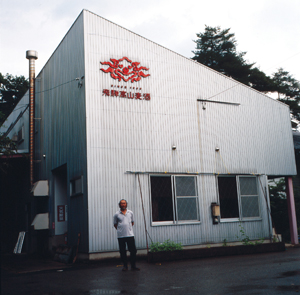As we pull into the green enclave of Hida Takayama Brewery, we worry we aren’t in the right place. The narrow road leading up to the entrance is old and overgrown on both sides, as if forgotten. The winding route from out of the provincial town had taken us through terraced rice fields. And just inside the entrance, to the left side, is a huge roofed pen with some two hundred head of cattle. But sure enough, rising up at the end of the driveway is a larger structure emblazoned with the brewery’s eye-catching logo.
The wiry, gray brewer, Azuchi Norihisa, greets us at the door and shows us into their slightly cluttered office. Reticent and rugged, like some mountain ascetic (he almost is), Azuchi describes the early days with a minimum of words. He isn’t being terse or unfriendly; he doesn’t have an air of being pressed for time; he speaks only what is necessary, as if the frugal ways of the farm inform his speech.
“I was originally just a cattle farmer, but wanted to do something more. Back in the 90s I heard the laws were going to change to allow for smaller-scale brewing. I figured I could do it with what resources I had. I didn’t know a thing about brewing beer, though. A friend of mine from Tokyo Agricultural University (Nodai) knew of a brewer from Sri Lanka, so I flew over there to meet him first. I thought it was kind of interesting that he was from a developing country.”
That brewer, Kolonghapitiya Padma, had actually trained in Germany and helped Azuchi start operations in 1996. A few of the flagship brews of Hidatakayama still reflect those German roots: pilsner, weizen, and dark ale. Other brews include a stout and a seasonal red bock. Their “Karumina,” an unusual dark beer akin to a barley wine, won a silver at the World Beer Cup in 2000. There are also two other seasonals with Sri Lankan names, the Rathumina, a slightly bitter dopplebock at 8%, and Thada Ratu, a malty red-brown ale with fruity notes at 6%.
Azuchi elaborates, “Padma brought his own recipes and we fiddled with them in the beginning. We had to dump a few. I didn’t think they were so bad, but we couldn’t take a chance. We won the silver medal in 2000 and haven’t changed our beers so much since then. We don’t make really bitter beers. I would describe ours as crisp and refreshing. It’s easier to drink if you ask me.”
We notice award certificates sitting in a loose pile on a table in the office. Awards won in earlier years, along with pictures of Padma, adorn a wall in the lobby.
“Padma stayed with us for about seven years, until he had a child and went back home. But Takahashi, our other brewer, learned here from Padma after graduating from Nodai.”
We spoke briefly with Takahashi at the Toyama Beer Festival the day before visiting the brewery. It was unusual to see Hida Takayama at a festival. It almost seems like their quiet redoubt in the hills of Gifu already provided them all they had aspired to. Azuchi somewhat confirms the observation.
“In the beginning, we did do some sales in places like Saitama and Tokyo, but we haven’t pushed it recently. We produce about 60 kiloliters of beer each year and most of that goes to Takayama.”
Hida Takayama is merely a production facility and offers no tours or tastings. There is no brewpub and probably never will be one in Takayama, a major tourist destination. There are roughly a dozen sake breweries concentrated in an historical district, and many of the adjoining restaurants also sell Hida Takayama beer. All the preserved traditional architecture draws its own crowds. And the town’s annual festival attracts thousands of people to view the floats. Bottles of good beer make for both a good introduction to Takayama and a good gift when going back home.
Most people also visit the nearby valley town of Shirakawa-go, a United Nations World Heritage site with dozens of old thatched-roof structures still used and inhabited by townsfolk. It’s a short bus ride from Takayama Station, where Takayama Meibutsu-kan, a local souvenir shop run by a lovely elderly couple, carries refrigerated bottles of Hida Takayama beer.
Azuchi sees us off after briefly showing us the brewery and other facilities. He mentioned having designed their logo himself and repairing brewery equipment on his own, so it’s not surprising to see his assistant feeding cattle by hand. As we pull out, he turns slowly like a farmer at the end of a day’s work, looking off at something in the trees, or maybe thinking, for just a moment, about his Sri Lankan friend over six thousand kilometers away.

This article was published in Japan Beer Times # () and is among the limited content available online. Order your copy through our online shop or download the digital version from the iTunes store to access the full contents of this issue.



